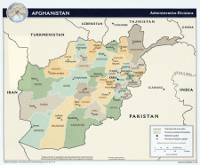Afghan police have detained the Taliban’s shadow governor for the central province of Bamyan.
Mullah Burhan, the shadow governor for Bamyan, “was appointed by the Taliban leadership to plan and carry out insurgent attacks in the peaceful central Afghan province, Governor Habiba Sarabi said,” according to a report in Quqnoos, an English language Afghan newspaper.
Governor Sarabi, Afghanistan’s first woman governor, warned that the Taliban are pushing into Bamyan from neighboring provinces where the insurgency is growing strong.
Bamyan borders Day Kundi, Ghazni, and Wardak to the south and east, and Baghlan to the north. The Taliban have increased their strength in these four provinces over the past two years. Much of Ghazni and Wardak provinces are considered contested or under Taliban control, while several northern districts in Baghlan are considered to be under Taliban control.
The Taliban push into central Afghanistan comes on the heels of the growing Taliban insurgency in the North and West. In northern Afghanistan, large regions in the provinces of Kunduz and Baghlan have fallen under the control of the Taliban. In the West, the Taliban control large areas in Baghlan and Farah provinces and have expanded their influence in regions in Herat province.
The Taliban establish shadow or parallel governments in the regions they control or where the Afghan government is weak. These shadow governments fill the void by dispensing sharia justice; mediating tribal and land disputes; collecting taxes; and recruiting, arming, and training fighters.
The Taliban have established shadow governments throughout Afghanistan, with provincial and militarily leaders appointed to command activities. In January 2009, the Taliban claimed to be in control of more than 70 percent of Afghanistan’s rural areas and to have established shadow governments in 31 of Afghanistan’s 34 provinces.
Taliban shadow government and military commanders have been high on the Coalition and Afghan target lists. In July 2008, several Taliban military commanders and members of the shadow government for Kandahar were killed in a series of strikes. In February 2009, the shadow governor of Afghanistan’s northwestern province of Badghis was killed during an airstrike on a village near the border with Turkmenistan.









1 Comment
The Thunder Run has linked to this post in the blog post From the Front: 10/01/2009 News and Personal dispatches from the front and the home front.